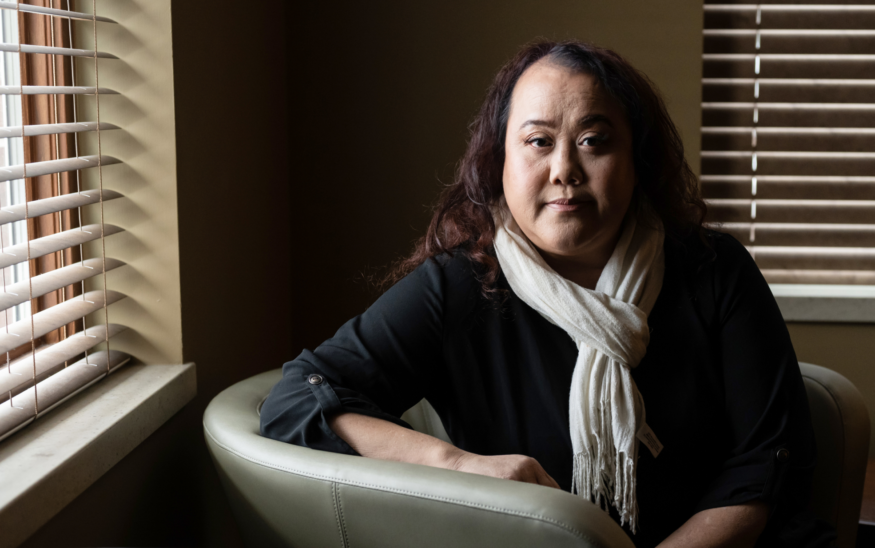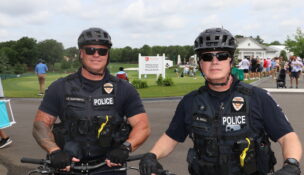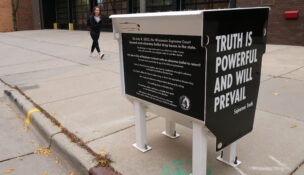How Hmong women in Wisconsin are tackling domestic violence in their communities
By: Bridgetower Media Newswires//July 16, 2024//
How Hmong women in Wisconsin are tackling domestic violence in their communities
By: Bridgetower Media Newswires//July 16, 2024//
Monica Lo stayed silent for years as the man she married abused her. She said he punched and even choked her — leaving her bruised and paralyzed by anxiety, even when she was six months pregnant in 1994.
Lo said she didn’t report the violence to law enforcement and lied to doctors about her injuries, saying at one point that a softball struck her.
She was taught to obey men and be submissive. She also feared speaking out would bring shame to her family.
“I didn’t want anybody to know what’s going on with me and my family,” Lo said in a recent interview.
The abuse escalated into a death threat along a highway in 1998, prompting Lo to wonder if she would survive or become yet another casualty of domestic violence.
Lo would ultimately escape the abuse and get back on her feet with help from The Women’s Community, Inc., a Wausau-based nonprofit that serves domestic violence and trafficking survivors. Her life would come full circle years later. She would go on to earn a master’s degree in social work at the University of Wisconsin-Madison before returning to Wausau to help Hmong women through challenges like she faced.
Lo, who has spent the last six years as an advocate and program coordinator for The Women’s Community, is among Hmong women who have spent years pushing back against attitudes that prevent women from reporting abuse and leaving violent relationships.
That includes offering safe housing, counseling and more representation in mediation processes that typically precede a divorce sanctioned by Hmong leaders. The women are also speaking out in an ongoing debate about the role patriarchal attitudes play in shaping scenarios that can prove deadly.
Hmong residents, the largest Asian racial ethnic group in Wisconsin, make up just 1% of Wisconsin’s population but have mourned a litany of killings linked to domestic abuse, particularly in and around Wausau, home to the highest per capita Hmong population in the United States. In an unofficial tally from news coverage and advocacy group reports, Wisconsin Watch counted 20 Wisconsin homicide cases since 1990 in which Hmong men have killed their intimate partners and, in some cases, additional women. Those include 14 cases since 2005.
More recent victims include Mai Rue “Lily” Vang of Wausau, described by loved ones as a generous friend, loving mother and deep listener. Even with her parents’ support, she struggled to leave a partner who abused her for years before killing her in March 2021.
Some Hmong men say blame for such violence should focus on individuals. They bristle when advocates say old cultural attitudes play a role. Those suggestions, some Hmong men say, stigmatize and divide Hmong communities that have remained tight-knit in Wisconsin since a generation arrived from refugee camps in Thailand after the Vietnam War.
To be sure, domestic violence is a national and statewide scourge that criminal justice and legal systems have struggled to address. Ninety-six people of various backgrounds in Wisconsin died due to domestic violence in 2022, according to the advocacy nonprofit End Domestic Abuse — a 20% increase from 2021 and the highest tally since the group began releasing such data in 2000.
But leaving abusive relationships can prove particularly challenging within traditional Hmong clan and family structures that value interdependence over independence and empower men to make most major decisions, advocates say. Sometimes taught to submit to their husbands and honor their clans, women may be blamed for triggering partner violence. When families negotiate terms of a marriage or separation, cultural divorce can prove particularly messy.
Cheeia Lo, executive director of the Green Bay-based domestic violence program Golden House, said that reporting abusers can have consequences in immigrant or refugee communities, where men are the main breadwinners.
“It takes individuals up to seven attempts to leave their abusers,” Lo said. “And the number is a lot higher in the Hmong community. I would say almost double that.”
Silence makes quantifying domestic violence difficult
How pervasive is domestic violence against Hmong women? That’s hard to measure, said Pa Thao, executive director of Black and Brown Womyn Power Coalition in Eau Claire. That’s because Hmong women often stay silent, as Monica Lo initially did, to avoid inflicting shame on themselves and their families.
Domestic violence survivors, regardless of ethnicity, often avoid speaking to law enforcement. Just 52% of domestic violence victims who responded to the 2019 National Crime Victimization Survey said they reported the violence to police.
Separately, a 2016 survey conducted for the state of Minnesota of 425 Asian women, 86 of them Hmong, found that just 11% of those who said they experienced violence reported it to police. More than 40% of respondents believed about half of the men in their community hit their wives.
Thao’s nonprofit runs a 24/7 Hmong-speaking helpline for survivors of domestic violence and their supporters. It received 117 calls, most from within Wisconsin, between October 2022 and September 2023 alone. Nearly two-thirds related to domestic violence at home, followed by 27% from service providers seeking consultation and 18% related to shelter and housing.
Those callers represent a tiny fraction of all who face domestic violence since many won’t call, Thao said.
“In our community, it’s really a taboo to talk about marital issues that are going on in the home and outside of the family structure.”
Addressing ‘abusive international marriages’
Thao said she is recently seeing a spike in violence later in the year when some Hmong men, wanting to visit Laos or Thailand during the Hmong New Year to marry young women or girls, turn violent if their wives in the U.S. refuse.
A 2008 Wisconsin Department of Justice report recounted multiple cases of young women or girls — one just 14 years old — being held as virtual prisoners after being brought to the U.S. for marriage.
Advocates for Hmong women have collected more recent narratives from first wives who were forced to live alongside their husbands’ young wives — still managing household work. Or they’ve been coaxed into a divorce, losing financial support and housing.
There is “one perpetrator and often two victims or multiple victims” in such relationships, said Chai Moua, co-executive director of Freedom, Inc., a Madison-based nonprofit that serves low- to no-income communities of color.
Moua and Thao are among advocates who want more Hmong women to tell their stories about gender-based violence they label “abusive international marriages” rather than human trafficking — and call for community leaders to condemn the practice.
Lo of Golden House said she has seen young brides from overseas with broken bones and bruises, fearing for their safety but also worried about deportation if they report abuse. Her agency has helped these women navigate the immigration system and overcome language barriers and other obstacles to escape abuse.
“It’s letting individuals know that there are resources out there to help them and that they’re not alone,” she said.
Clan, family structures can complicate divorce
Hmong Americans organize themselves in an 18-clan structure, with clans recognizing a common ancestor. Clans play a major role in family dynamics, including cultural marriage and divorce. Hmong Americans traditionally choose spouses from outside their birth clans, and families negotiate terms of cultural marriage or divorce or funerals. A Hmong wife will traditionally join her husband’s clan and family, which typically gives the husband more power in decision-making.
Such interdependence can make leaving an abusive relationship particularly challenging, Hmong advocates say. Cultural divorce involves an agreement among clans and can include lengthy mediation sessions that prioritize keeping a couple together.
It took years for Monica Lo to contemplate divorce, even as the abuse escalated, she said. Divorce can bring isolation and new housing needs. But within a year of experiencing the 1998 death threat along the highway, at age 25, she resolved to leave a marriage that started just after high school.
Her first step: phoning The Women’s Community after finding its number in the Yellow Pages. It helped her petition a court for a restraining order, and it offered temporary shelter and additional support to Lo and her son as she planned her next steps.
Lo said her father supported her, and both of her parents agreed to help with child care, but finalizing the cultural divorce took time because it required her then-husband’s clan to agree.
That happened only after three mediation sessions — each lasting three or four hours — in which male clan leaders, she said, encouraged her to remain in the relationship before it became clear that the violence persisted.
Improving services for domestic violence survivors
Jane Graham Jennings, executive director of The Women’s Community, remembers seeing Lo when she turned to the agency for help in 1999. It was early in Jennings’ tenure at the nonprofit and around its launch of culturally specific services for Hmong clients.
Leading that effort was the late Mao Khang, a fierce advocate for Hmong women facing domestic violence. She went on to become the first woman to sit on the Hmong 18 Clan Council of Wisconsin, founded by General Vang Pao in 1985 to provide a “social, economic, and cultural support system” for the Hmong families. That includes resolving conflicts through mediation as a bridge between traditional Hmong practices and American law.
Initially, when clients would ask Women’s Community staff to explain to their husbands the legal ramifications of abusive behavior, Jennings would decline — saying her organization served victims and didn’t talk to harm-doers. Khang changed that mindset, Jennings said.
“We don’t decide what victims need,” Jennings said. “They tell us what they need, and we figure it out.”
Outraged in the mid-2000s after a series of domestic violence-related homicides of Hmong women in Wisconsin, Khang challenged the clan system to change its treatment of survivors.
Khang was among those who brought Pao to Wausau in 2009. The military and cultural leader — revered by many Hmong people before he died in 2011 — condemned domestic violence in a speech, saying men who participate in such practices “are creating a disease.”
After Pao’s visit, Wisconsin Hmong leaders put his words in a handbook to guide the 18 Clan Council, urging leaders to treat women equally and fairly.
Making mediation more inclusive
Soon after Pao’s visit, Khang led The Women’s Community’s expansion of services for Hmong women and set up its own mediation services for couples who want some clan involvement in a cultural divorce.
That process involves bringing together leaders from each spouse’s clan and immediate family. The goal: respecting each side’s wishes. It’s unlike traditional mediation, which primarily aims to keep couples together and tends to take much longer. When mediation results in a divorce, the nonprofit may bring in a family law attorney to guide each party through legal requirements.
This type of mediation has yielded promising results, Jennings said, with clan leaders more likely to grant cultural divorces, allowing women to move on. But she acknowledged fewer couples are seeking mediation since Khang died of liver cancer in 2022.

Nao Shoua Xiong, a military veteran, is among three clan leaders who have collaborated with The Women’s Community in mediation. He said he has mediated nearly 200 cases involving a cultural divorce since 2000. Those include about 20 cases in collaboration with The Women’s Community.
Xiong said he urges spouses to stay faithful, end extramarital relationships and respect their clans. Those who refuse may face monetary fines.
The majority of couples remain married after traditional mediation. In one recent year, couples in 25 of the 38 cases he mediated stayed together, he said in Hmong as Wisconsin Watch interviewed him through a translator.
Xiong said mediation helps de-escalate abuse and violence. He often advises husbands to consider the impacts of their actions on children as well.
When violence persists in extreme cases, he said, mediation stops.
“That’s it. There’s no negotiations,” he said. “They have to go and do it the legal way.”
Xiong said roughly half of today’s Hmong couples — and they tend to be younger —will bypass the clan system and go straight to the courthouse for divorce.
Xiong is among those who don’t see domestic violence as structural within Hmong communities.
“It’s not a community problem. It’s an individual problem,” he told Wisconsin Watch. “It’s an issue where everybody is responsible for their own actions.”
Advocates who serve Hmong women disagree, saying perpetrators may be fathers, uncles and grandfathers who hold sway and are supposed to act as moral compasses.
“But it doesn’t stop us from talking about it,” said Lo of the Golden House.
Remembering Lily Vang
Clan mediation didn’t save Lily Vang from her partner Umberto Lo. Lo murdered the 30-year-old nail technician following at least seven instances dating back to 2018 in which Wausau police responded to domestic abuse complaints.
That included one complaint when Vang was five months pregnant in April 2020. Police reports show Vang called the police at the suggestion of Umberto Lo’s mother. Vang told the responding officer that Lo, now 27, had sworn at her and shoved her. Police arrested Lo, who faced charges of disorderly conduct with domestic abuse and repeater enhancements. He was released after posting a $1,500 bond and ordered not to contact Vang.
Less than a year later, Vang was found dead on the floor of her apartment. The couple’s two children were in the same bedroom when Lo fatally shot their mother, according to police reports.
A jury last January found Lo guilty of first-degree intentional homicide. In May, a circuit court judge sentenced him to life without extended supervision.
Feanna Vang, Lily’s youngest sister, wishes she had more strongly urged Lily to leave the relationship. Feanna said Lily would confide in her, saying the relationships provided some sense of security. Feanna said she listened without offering much pushback.
Their older siblings did urge Lily to leave, warning her of the grave risks otherwise — for herself and her children, Feanna said.
At The Women’s Community, Monica Lo closely followed the case. She said Lily tried hard to exit the relationship, even seeking clan mediation, but her partner refused to cooperate with either clan.
Lo said Lily’s death illustrates a situation many younger Hmong American women find themselves in: adapting to American cultural and legal norms that frown upon abuse while maintaining some patriarchal ideas.
To honor Lily, Feanna, who in May graduated from UW-Madison after majoring in psychology, dreams of opening a mental health clinic with an in-house nail salon to allow clients to express themselves freely.
Monica Lo aims to build upon Khang’s legacy, challenging patriarchal views while remaining proud of her Hmong heritage and culture. Both are possible, she said.
She is optimistic that younger generations will strike that balance. She’s encouraging her 29-year-old son to join a movement that requires buy-in from men to succeed.
“It’s your generation that will have to try to change us more,” she said. “It’s gonna take another generation, two, or three generations.”
This article first appeared on Wisconsin Watch and is republished here under a Creative Commons license.![]()
Legal News
- How Hmong women in Wisconsin are tackling domestic violence in their communities
- Beloit School District rescinds scholarship’s racial eligibility criterion following WILL’s legal threat
- Day One RNC: Trump taps VP; protests erupt during nomination
- Law enforcement from Tulsa to Maryland and North Carolina volunteer to assist during RNC
- Republicans are gathering in Milwaukee to nominate Donald Trump again. Here’s what to expect
- Wisconsin election officials tell clerks best ways to operate absentee ballot drop boxes
- Family vows during funeral to push for charges after Black man pinned to ground outside Milwaukee hotel
- Melania Trump will attend the Republican convention in a rare political appearance, AP sources say
- Wisconsin officials react to President Trump’s attempted assassination
- FBI early Sunday identified Trump shooter as Thomas Matthew Crooks
- Donald Trump whisked off stage in Pennsylvania after apparent gunshots rang through the crowd
- Wisconsin Elder Abuse Hotline receives prestigious aging achievement award from USAging
Case Digests
- Absentee Ballot Drop Boxes
- Separation of Powers- Legislative Oversight of Executive Actions
- Notice of Recommitment and Involuntary Medication Hearings
- Firearm Possession-Sufficiency of Evidence
- Motion for Substitute Counsel
- Jury Instructions
- Equal Credit Opportunity Act
- Fourth and 14th Amendment Rights-Parental Medical Neglect
- Eminent Domain
- Intrusion Upon Seclusion Claim-§1983 claim
- Employment Law- Title VII
- Employment Law












